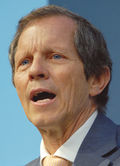The Airline Industry's Global Warming Denial
 Giovanni Bisignani, the director general and chief executive of the International Air Transport Association (IATA), is a worried man. As the head of the global civil aviation's main lobby group, which represents companies such as American Airlines, Delta Airlines, Qantas, British Airways and Virgin Atlantic, Bisignani (right) has been frantically working to ensure that IATA isn't stripped of its its exemption from the Kyoto Protocol at the COP15 conference, which opens in Copenhagen next week.
Giovanni Bisignani, the director general and chief executive of the International Air Transport Association (IATA), is a worried man. As the head of the global civil aviation's main lobby group, which represents companies such as American Airlines, Delta Airlines, Qantas, British Airways and Virgin Atlantic, Bisignani (right) has been frantically working to ensure that IATA isn't stripped of its its exemption from the Kyoto Protocol at the COP15 conference, which opens in Copenhagen next week.
In a recent IATA newsletter, Bisignani anxiously pondered "how to make Copenhagen a success" for the airline industry. "Our message must be heard far more broadly. Ministers of transport know our story but they are not driving the agenda. Heads of state and environment ministers are the target audience. IATA cannot be the lone campaigner. I need your help to ensure that our industry’s track record, vision and commitment are known by every UNFCCC [United Nations Framework Convention on Climate Change] delegate," he wrote.
But the airline industry's track record of denial, delay and inaction is at the very heart of why many UNFCCC delegates are no longer willing to trust that IATA or the International Civil Aviation Organization (ICAO), the UN agency for civil aviation, will make any meaningful contribution to cutting greenhouse gas emissions from the sector.
The aviation industry, along with the shipping industry, has been one of the most recalcitrant industry sectors in addressing global warming. Despite this, IATA generates world-class rhetoric. In one 2005 document, IATA even went so far as to oxymoronically claim that "air transport contributes to the stabilisation of greenhouse gas emissions in the atmosphere by continuously increasing fuel and carbon efficiency." (Not surprisngly, IATA is one of the nominees for the inaugural Angry Mermaid Award for companies and lobby groups that have "made the greatest effort to sabotage the climate talks, and other climate measures, while promoting often profitable false solutions.")
Flight from Responsibility
When the Kyoto Protocol was finalised in late 1997, it simply stated (pdf) that the [Annex I Parties|Annex I industrialised countries] "shall pursue limitation or reduction of emissions of greenhouse gases" from the aviation sector by working through ICAO. At the time, ICAO explained in a media release (pdf) that aviation had been excluded "because of the difficulty in allocating them to specific countries. For example, which country should be responsible for emissions involving an airline from the Americas flying over the Middle East, between a country in Europe and another in Asia?"
Twelve years on and ICAO has made little progress in gaining agreement on how to cut emissions, let alone implement any significant changes. The most recent United Nations Framework Convention on Climate Change report noted that international aviation emissions from developed countries rose (pdf, see page 13) by 65.8% between 1990 and 2005. Despite rapidly rising emissions, Bisignani claimed in a September 2007 opinion column in the New York Times that the airline industry's contribution to global warming had "remained largely unchanged over the last two decades, despite the growth of air traffic."
Aside from such overblown rhehoric, IATA has adopted a four-pronged public relations strategy for defusing concern over its environmental impact. Firstly, it promotes increased fuel efficiency as the benchmark against which the industry should be judged. Secondly, it hypes the fact that some of its member companies offer passengers the option of participating in a carbon offset program. Thirdly, one of its key lobbying aims in 2009 was to "secure the support" of International Civil Aviation Organization for IATA's "four-pillar strategy" of "investing in technology", "flying planes effectively", "building efficient infrastructure" and "using positive economic measures."
Finally, IATA, like the best of the global warming skeptics, is keen to emphasise scientific uncertainties about global warming. "Although the natural greenhouse effect is vital for human existence, many scientists believe that additional warming linked to human activity may cause our climate to change irreversibly. However scientists disagree over the amount, probability and nature of these changes," it states on its website.
High-Flying Greenwash
In June 2009, IATA airlines launched a bold-sounding strategy aimed at projecting the image of determined action by the industry. In its plan (pdf), IATA outlined that it had committed itself to: "A cap on aviation CO2 emissions from 2020 (carbon-neutral growth)" "; An average improvement in fuel efficiency of 1.5% per year from 2009 to 2020"; and "A reduction in CO2 emissions of 50% by 2050, relative to 2005 levels".
 At the same time, IATA produced a series of in-flight magazine ads (right) "with the support" of Airbus, The Boeing Company, Pratt & Whitney and Rolls-Royce to sell the industry's environmental credentials to passengers. All of the ads include variations on the statement that airlines are taking steps "to limit the 2% of carbon emissions attributed to air transport."
At the same time, IATA produced a series of in-flight magazine ads (right) "with the support" of Airbus, The Boeing Company, Pratt & Whitney and Rolls-Royce to sell the industry's environmental credentials to passengers. All of the ads include variations on the statement that airlines are taking steps "to limit the 2% of carbon emissions attributed to air transport."
But it is claims like these that have been ridiculed by European Federation for Transport and Environment (T&E), a non-government advocacy group specialising in transport policy.
While IATA routinely cites the figure of the aviation industry being responsible for only 2% of carbon dioxide emissions, this excludes the contribution to global warming from nitogen oxides, condensation trails created in the wake of aircraft and the formation of cirrus clouds, which have been calculated to be 2 to 5 times the global warming impact of carbon dioxide alone.
In a bid to quarantine restrictions to only carbon dioxide, IATA claims that "little is known about the effect of contrails, cirrus cloud formation and the methane-reducing capabilities" of nitrogen oxides." T&E argues that the real impact of airlines emissions, based on 2000 figures, would be between 4 and 9%.
So while IATA states that it is willing to put a cap on carbon dioxide emissions in 2020, this is not the same as a putting cap on all greenhouse gas emissions for aircraft. Even worse, their ambit claim is to be allowed to have another ten years of unconstrained growth in emissions before a cap is imposed. Even then, the 2% figure IATA routinely cites is outdated, as it is based on 1992 data which was then cited in the Intergovernmental Panel on Climate Change's 1999 special report, Aviation and the Global Atmosphere.
IATA's goal of increasing fuel efficiency by 1.5% per annum is just as hollow. A report commissioned by T&E from the Dutch National Aerospace Laboratory noted (pdf) that assessments of fuel efficiency gains by aircraft vary between 1.4% and 2.2% a year. IATA's proposal, then, amounts to little more than dressing the status quo up as something new.
Nor does IATA's suggestion that it would reduce carbon dioxide emissions by 50% by 2050 amount to much. Firstly, IATA prefer to base their target on 2005 data, rather than the base year of 1990 currently used as the benchmark in the Kyoto Protocol. IATA is not alone in wanting to shift the goalposts so that their emissions reduction goals appear larger than is required to effectively mitigate global warming.
Secondly, IATA's commitment is confined to only carbon dioxide, not all of the aviation sector's greenhouse gas emissions. Finally, an aspirational goal is one thing, but it only amounts to anything of substance if there is a mechanism to drive change. As demonstrated in the last twelve years, self-regulation and limited market forces aren't doing the job.
The Limits of Efficiency
The extent of IATA's gesture towards the need for reform is in trying to sell the idea that efficiency gains, supplemented by other changes such as rationalising flight routes, are all that are needed.
Whenever it gets the chance, IATA trumpets the claim that "new aircraft are 70% more fuel efficient than 40 years ago." But this is a claim that T&E points out -- based on the Dutch National Aerospace Laboratory report -- only addresses fuel efficiency during the jet era. Setting the starting date for calculating the efficiency gains at the 50 year mark is more revealing. "Over the last 50 years there has, in fact, been scarcely any improvement at all in aircraft fuel efficiency. Aircraft manufactured in the early 1950s – such as the Lockheed Constellation – were two to three times as fuel efficient as the early jets that succeeded them and virtually as efficient as the aircraft sold today," T&E states.
Even using the 40 year mark, the Dutch National Aerospace Laboratory estimated the efficiency gain during the jet era as being 55%, not IATA's claimed 70%.
While options exist for increasing the fuel efficiency of aviation -- from more fuel-efficient engines to design innovations in the aircraft body -- these changes have long lead times before deployment and can incrementally affect only a small percentage of the airfleet. The IPCC notes (pdf, see page 353) that approximately 60% of aircraft are still in service after 30 years and that this "results in slower change than might be seen in other transport forms."
The IPCC's sobering conclusion was that "even the most ambitious scenario [of efficiency gains] suggests that CO2 production will increase by almost 100% from the base year ... The analysis suggests that aviation emissions will continue to grow as a result of continued demand for civil aviation. Assuming the historical fuel efficiency trend produced by industry developments will continue (albeit at a declining level), carbon emissions will also grow, but at a lower rate than traffic. Carbon pricing could effect further emissions reductions if the aviation industry introduces further technology measures in response.."
The U.S. Government Accountability Office (GAO) also cast doubt on the likelihood that reliance on technological innovation alone would make much difference by 2050. The GAO concluded that "given expected growth of commercial aviation as forecasted by IPCC, even if many of these [efficiency] improvements are adopted, it appears unlikely they would greatly reduce emissions by 2050."
As awareness of the contribution of air travel to global warming increases, some environmental groups are urging consumers to cut back on planned travel. An early indicator that a shift in attitudes may be underway is the recent decision by the U.K.-based travel company, ResponsibleTravel.com, to stop promoting carbon offsets on the grounds that it "distracts from the real issues" of reducing emissions. "Offsetting flights has too often been seen as an opportunity to go on flying the same amount or more," it states on its Website. Instead, the company is now urging consumers to "fly less" and to make lifestyle changes to cut carbon emissions.
But that is the very scenario that IATA refuses to contemplate, preferring to hype efficiency gains and promote another decade of emissions growth. Whether the aviation industry can manage a Houdini-style escape from Copenhagen without being forced to accept binding emissions targets remains to be seen.
Bob Burton is the Managing Editor of SourceWatch.
Many of the links in the above article are to articles on SourceWatch, the Center for Media and Democracy's collaborative online encyclopedia (which has a special section on climate change). You can help add to and improve the existing articles.
If this is your first time editing on SourceWatch, you can register here, and learn more about adding information to the site here, here, here and here. If you have never added material to SourceWatch before, don't worry! Our regular editors are at hand to help get you started.




